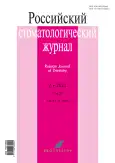Experimental comparison of screw loosening of full zirconia crowns supported by straight implants, straight implants with angled abutments, and angled implants with different platform inclinations: An in vitro study
- Authors: Merzhoeva K.M.1, Murashov M.A.2, Voronov I.A.1
-
Affiliations:
- People’s Friendship University of Russia
- Moscow State University of Medicine and Dentistry
- Issue: Vol 27, No 2 (2023)
- Pages: 121-128
- Section: Experimental and Theoretical Investigation
- URL: https://journals.rcsi.science/1728-2802/article/view/131235
- DOI: https://doi.org/10.17816/dent321722
- ID: 131235
Cite item
Abstract
BACKGROUND: The success of placing an immediate implant in the area of the maxillary central incisor depends on the degree of tightening of the fixation screw for full zirconia crown. Clinicians use implants of various designs and angled abutments to bypass anatomical limitations, achieve a stable primary implant, and fabricate a screw-retained crown. However, a crown fabricated for an implant can experience non-axial loads during occlusion, which can loosen screws and adversely affect treatment success, particularly during the early postoperative period.
AIM: To compare the effect of cyclic loading on the reliability of the fixation screw for a full zirconia crown supported by an angled implant with platform inclinations of 12, 24, and 36 using straight implants or straight implants with an angled abutments.
MATERIALS AND METHODS: The degree of prosthetic screw tightening was studied in 30 samples (six groups of 5 implant types, such as straight implants, straight implants with standard 17° angled abutments, or 12° custom abutments and angled implants with platform inclinations of 12°, 24°, and 36°). A full zirconia crown was fabricated for the maxillary central incisor, fixed on every implant, and exposed to cyclic loading for 1×106 cycles. Then, the maximum unscrewing torque was determined for each group, and statistical analysis was carried out.
RESULTS: The minimum values of the maximum torque value was 20.804±0.01 N/cm for the group of straight implants with 17° angled abutments and the maximum value for the group of straight implants was 22.82±0.04 N/cm. However, the values in these groups were higher than those of the groups of implants with angled abutments.
CONCLUSION: This study showed that fixation screws are more reliable in crowns supported by straight implants or angled implants with different platform inclinations. Therefore, these implants are the preferred option for placing an implant in the anterior region.
Full Text
##article.viewOnOriginalSite##About the authors
Khava M. Merzhoeva
People’s Friendship University of Russia
Email: kh_a_va@mail.ru
ORCID iD: 0000-0002-4049-6229
SPIN-code: 3549-7597
Postgraduate Student
Russian Federation, MoscowMikhail A. Murashov
Moscow State University of Medicine and Dentistry
Author for correspondence.
Email: mmurashov@yahoo.com
ORCID iD: 0000-0002-3309-538X
SPIN-code: 3355-6397
MD, Cand. Sci. (Med.), Assistant Professor
Russian Federation, MoscowIgor A. Voronov
People’s Friendship University of Russia
Email: voronov77@mail.ru
ORCID iD: 0000-0002-6873-5869
SPIN-code: 8186-2654
MD, Cand. Sci. (Med.), Associate Professor
Russian Federation, MoscowReferences
- Koh RU, Rudek I, Wang HL. Immediate implant placement: positives and negatives. Implant Dent. 2010;19(2):98–108. doi: 10.1097/ID.0b013e3181d47eaf
- Bassir SH, El Kholy K, Chen CY, et al. Outcome of early dental implant placement versus other dental implant placement protocols: A systematic review and meta-analysis. J Periodontol. 2019;90(5):493–506. doi: 10.1002/JPER.18-0338
- Ebenezer V, Balakrishnan K, Asir RV, Sragunar B. Immediate placement of endosseous implants into the extraction sockets. J Pharm Bioallied Sci. 2015;7(Suppl 1):S234–S237. doi: 10.4103/0975-7406.155926
- Korsch M, Obst U, Walther W. Cement-associated peri-implantitis: a retrospective clinical observational study of fixed implant-supported restorations using a methacrylate cement. Clin Oral Implants Res. 2014;25(7):797–802. doi: 10.1111/clr.12173
- Korsch M, Robra BP, Walther W. Cement-associated signs of inflammation: retrospective analysis of the effect of excess cement on peri-implant tissue. Int J Prosthodont. 2015;28(1):11–18. doi: 10.11607/ijp.4043
- Korsch M, Walther W. Peri-Implantitis Associated with Type of Cement: A Retrospective Analysis of Different Types of Cement and Their Clinical Correlation to the Peri-Implant Tissue. Clin Implant Dent Relat Res. 2015;17(Suppl 2):e434–e443. doi: 10.1111/cid.12265
- Staubli N, Walter C, Schmidt JC, et al. Excess cement and the risk of peri-implant disease — a systematic review. Clin Oral Implants Res. 2017;28(10):1278–1290. doi: 10.1111/clr.12954
- Merzhoeva KhM, Murashov MA, Voronov IA. Cone-beam computed tomography evaluation of the possibility of fabrication of screw-retained implant crowns on maxillary central incisors. Russian Journal of Dentistry. 2022;26(4):337–344. (In Russ). doi: 10.17816/1728-2802-2021-26-4-337-344
- Jones A, Chávarri-Prado D, Diéguez-Pereira M, et al. Prevalence of Favorable Anatomy for Palatal Emergence of an Immediate Implant in the Maxillary Central Incisor Post-Extraction Site. J Oral Implantol. 2022;48(5):399–406. doi: 10.1563/aaid-joi-D-20-00275
- Murashov MA, Shorstov YaV, Venter IV. Ispol’zovanie uglovykh implantatov kak al’ternativnyi metod slozhnym resheniyam v implantatsii i protezirovanii. Digital Dentistry. 2019;1(10):40-45. (In Russ).
- Howes D. Angled Implant Design to Accommodate Screw-retained Implant-supported Prostheses. Compend Contin Educ Dent. 2017;38(7):458–463.
- Pitman J, van Craenenbroeck M, Glibert M, Christiaens V. Screw loosening in angulation-correcting single implant restorations: A systematic review of in vitro studies. J Prosthet Dent. 2022:S0022-3913(22)00483-8. doi: 10.1016/j.prosdent.2022.08.003
- Hotinski E, Dudley J. Abutment screw loosening in angulation-correcting implants: An in vitro study. J Prosthet Dent. 2019;121(1):151–155. doi: 10.1016/j.prosdent.2018.03.005
- Klongbunjit D, Aunmeungtong W, Khongkhunthian P. Implant-abutment screw removal torque values between customized titanium abutment, straight titanium abutment, and hybrid zirconia abutment after a million cyclic loading: an in vitro comparative study. Int J Implant Dent. 2021;7(1):98. doi: 10.1186/s40729-021-00378-z
- Swamidass RS, Kan JYK, Kattadiyil MT, et al. Abutment screw torque changes with straight and angled screw-access channels. J Prosthet Dent. 2021;125(4):675–681. doi: 10.1016/j.prosdent.2020.01.018
- International Organization for Standardization. ISO 14801:2016. Dentistryimplants-dynamic loading test for endosseous dental implants. Geneva: International Organization for Standardization; 2016.
- Ferrario VF, Sforza C, Serrao G, et al. Single tooth bite forces in healthy young adults. J Oral Rehabil. 2004;31(1):18–22. doi: 10.1046/j.0305-182x.2003.01179.x
Supplementary files






















